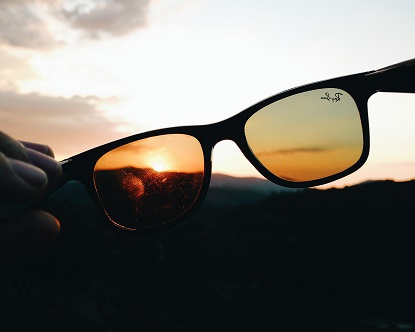Sunglasses can prevent sun damage to your eyes, improve your vision and make a unique fashion statement. Learn about the different types of sunglasses, including polarized lenses and the latest sunglass styles, in this series of articles written by experts in eye care.
Now you need to find just the right pair. There are a lot of choices and factors that go into getting the sunglasses you want — from the ideal frame for your face shape to lenses that best block UV rays — and we’ve made it easier for you to make that decision with this buyer’s guide to sunglasses.
How to Pick Sunglasses for Your Face Shape
Find a Frame that Fits
Too loose. Too tight. Too big. Too small. Don’t settle for sunglasses that don’t fit! Keep comfort in mind and consider your face size and shape:
- Measure the dimensions of your face. Stand in front of a mirror or have a friend:
- Measure your forehead width; temple to temple.
- Measure from the top of one cheekbone to the other.
- Measure face length, from the center of your hairline down to your chin.
- Measure your jaw line, located directly under each ear and connected down by the chin.
- Write down all measurements and compare to both the dimensions of your face and the sunglasses you’re considering (frame, lens and bridge width, for example).
- Determine the shape of your face. This graphical chart is a great visual reference on how to pick sunglasses for your face shape. Review the four main face types and consider which sunglass styles will work best for you:
- Square: A strong jawline and broad forehead are typical characteristics. Sunglass styles like aviators and other soft-lined oval / circular frames work well.
- Oval: A longer-than-wide face shape means you can wear most frames and look great doing it.
- Round: Curviness rules, defined angles don’t. Try oversized, rectangular or angular sunglasses that offset round faces.
- Heart: Wide at the temples and narrow at the chin, heart-shaped faces strike a balanced look with frames that are wider on top than on the bottom. Wayfarer, cat-eye and sport styles make great options.
Top Sunglass Trends
Now that you know a little more about which styles are the right fit, let’s look at the hottest sunglass trends. A constant theme is that old is definitely new again, and frames that were crazes as far back as the 1920s have re-emerged and are as popular as ever. Here are a few of our favorites:
- Wayfarer sunglasses: Ray-Ban started the plastic framed wayfarer rage back in the 1950s, and it’s certainly come back in popularity. Wider on top, oftentimes with the corners sticking out a smidge, wayfarer sunglasses suit casual spring and summer styles with ease.
- Aviators sunglasses: Dating back to the 1930s, aviators were proudly worn by pilots and military personnel, and even became one of the first popularized styles ever made. Typical features include dark, mirrored lenses held together by thin metal frames.
- D-Frame sunglasses: Rocking a retro-chic look, these smart shades boast a straight line across the top, oftentimes with a slight indentation at the nose bridge. A plastic frame is pretty common.
- Mirrored sunglasses: Reflect your confident persona with sleek mirrored styles. Aviators lead the pack in popularity, but mirrored sunglasses cover a wide range of frame and lens shapes and sizes. Plus, they just look so cool.
- Cat-eye sunglasses: Purrfect for round and heart-shaped faces, these frames usually feature pointy top corners, mimicking the look of cat ears. A fun way to show your frisky side, for sure.
Other Considerations for Selecting the Best Shades
You’re almost ready to rock that new pair of shades! Here are a few more helpful tidbits you should keep in mind before you buy.
Need prescription sunglasses?
If you wear contacts exclusively, there’s no need to go buy prescription shades. Those who don eyeglasses exclusively, or both eyeglasses and contacts, would benefit from getting prescription sunglasses. Consult your optometrist for more details on what’s right for you.
UV protection sunglasses
UV protection is still important! Seek out shades with a sticker that says they block 100% of UVA and UVB rays. No sticker? Check with the salesperson. If it’s not 100%, leave them on the rack and find another pair. Wraparound and other close-fitting sunglasses protect a larger area, making it more difficult for the sun to sneak in.
Sunglass prices
From $1 to $1,000+, prices obviously range a great deal when buying sunglasses. But it ultimately comes down to what you’re comfortable with. More expensive designer sunglasses no doubt sport style and good quality, but don’t rule out a less expensive pair that fits and looks great just because they may not be considered a top brand.
We hope this sunglass guide has given you the information necessary to make an informed purchase decision. Just remember: pick sunglasses that fit your face and persona and you’ll have it made in the shade.
Sources:
BUYER’S GUIDE TO SUNGLASSES, BDP NEWS | MAY 9, 2017
Make your appointment today
To make your appointment, simply give us a call (760)-948-3345 or
or
Due to COVID-19 safety protocols, all eyewear services are currently by appointment only. Please call to make an appointment.
At Golden Eye Optometry, we view good vision care as front line protection at every age. A routine eye exam can detect more than poor vision. It can shed early light on glaucoma, macular degeneration, cataracts and diabetes.
Thank you for sharing this amazing information with us.